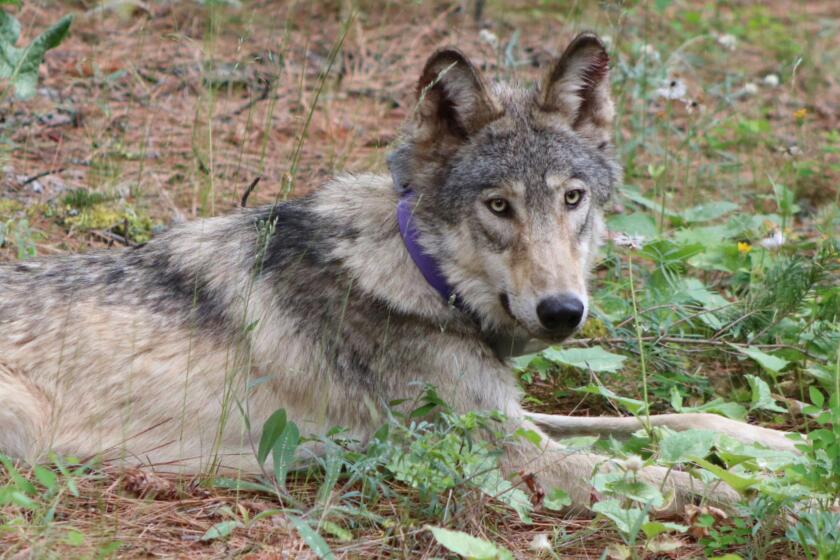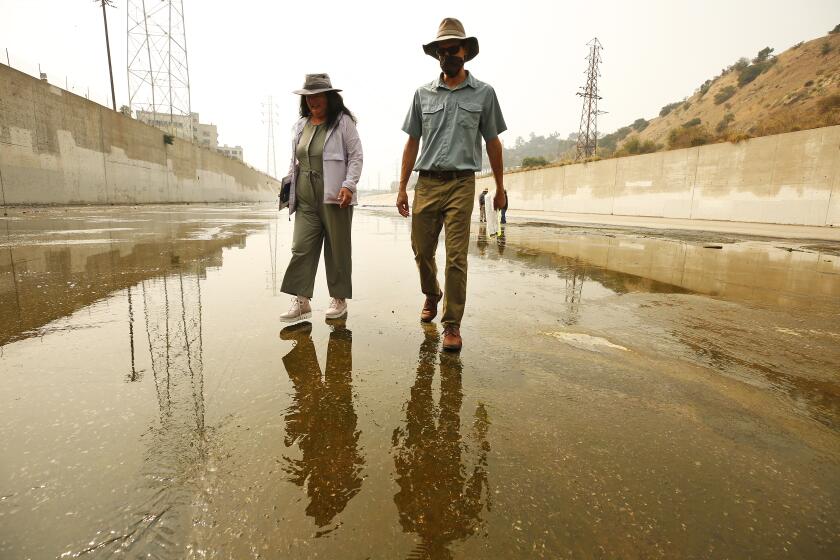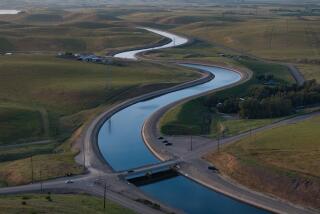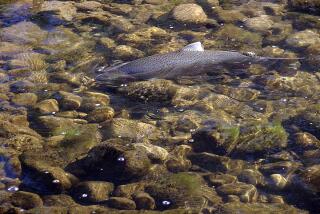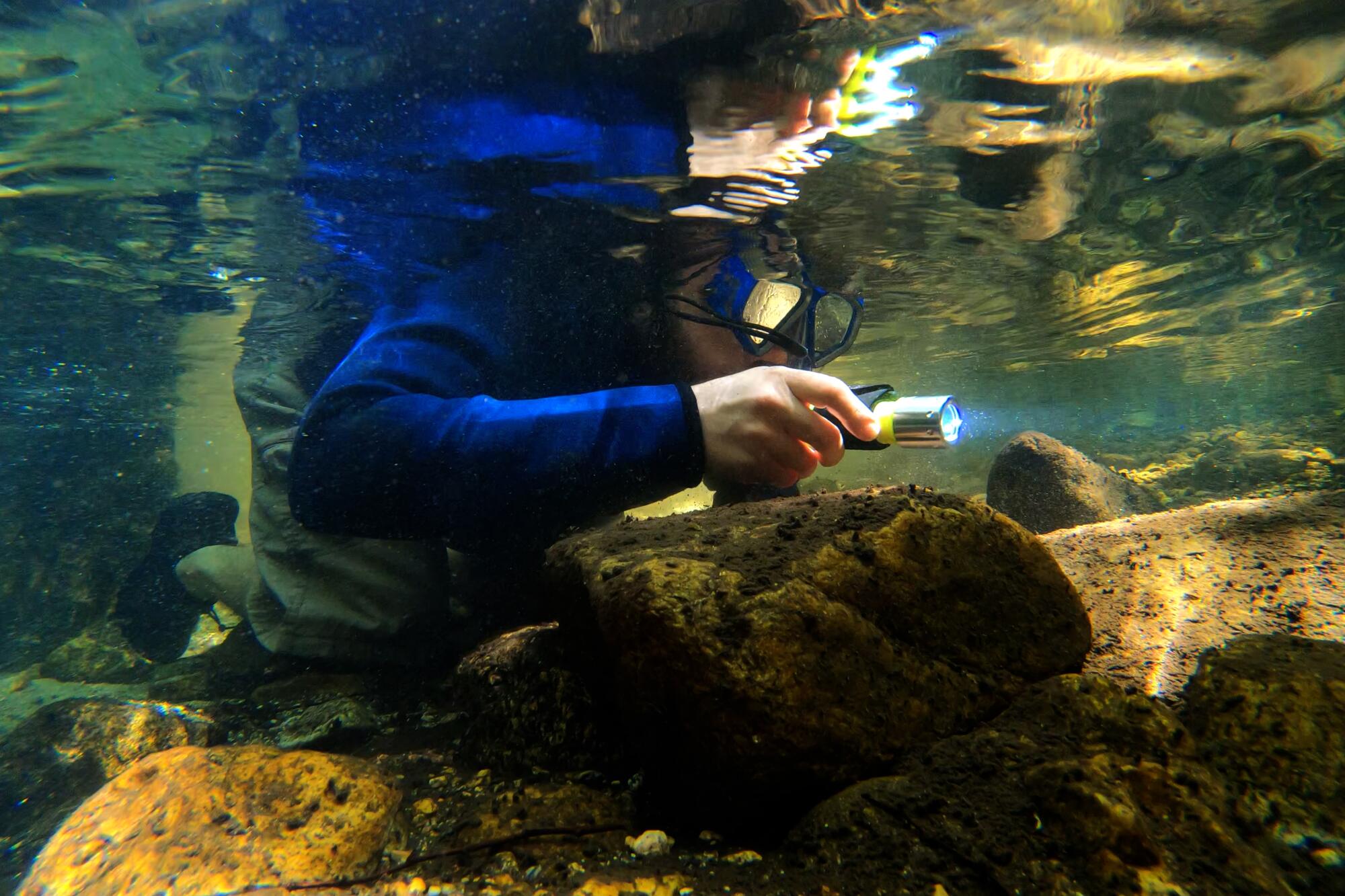
In an era of increasing drought and nearly back-to-back wildfires, state conservationists have been working overtime in the San Gabriel Mountains to rescue frogs, fish and other species facing potential oblivion by rounding up populations of threatened animals and transporting them to safer areas.
While most of these efforts have occurred in obscurity, one recent mission to save hundreds of doomed rainbow trout has touched off a heated battle between humans and fish over the clear waters of Pasadena’s Arroyo Seco. The controversy has also served to highlight the challenges wildlife biologists now face as they search for havens amid Southern California’s patchwork of urban development, wildfire scars and seasonal mudslides.
After last summer’s Bobcat fire burned more than 115,000 acres of wrinkled slopes and lush canyons, state biologists began to worry that a native population of rainbow trout living in the West Fork of the San Gabriel River could be wiped out if winter storms unleashed a muddy avalanche of slurry, sediment and fire debris into the waterway. They soon hatched a plan to translocate 469 rainbows to the Arroyo Seco, a winding creek that snakes past the Jet Propulsion Laboratory some 30 miles away.
Translocation occurs when animals are moved to areas that are not within their home range, whereas relocation describes moving animals to another area within their home range. In explaining its decision to translocate the trout, the state Department of Fish and Wildlife said doing so provided an opportunity to preserve valuable genetic stock and “potentially reestablish a native rainbow trout population” in the stream where fish had been decimated by the 2009 Station fire.
Hundreds of translocated native rainbow trout are trying to survive in Pasadena’s Arroyo Seco. (Carolyn Cole / Los Angeles Times)
The trouble is, the city of Pasadena currently gets about 35% of its water supply from the Arroyo Seco, and the surprise dump of squirming trout has raised new criticism of its $15-million plan to draw more water from the stream. That’s largely because Pasadena Water and Power’s environmental impact report on the Arroyo Seco Canyon Project claimed there were no fish in the creek.
The project would boost the city’s ability to gather and store water by replacing a vintage, 3-foot-tall dam, and by improving a diversion system that directs the arroyo’s water to spreading basins that allow it percolate into the underground aquifer known as Raymond Basin. It would also repair and replace water facilities damaged by the 2009 Station fire.
Conservationists have been fighting for several years to downscale the project proposal, and would ultimately like the creek returned to its natural state. Doing so, they say, would allow it to better refill the aquifer, restore the environment and accommodate fish.
Deepening the mystery, officials have not picked up a ‘mortality signal’ from OR-93’s radio collar, indicating that the wolf had not moved for at least eight hours.
The sudden introduction of rainbow trout has added more weight to their cause, because the city can no longer argue there are no fish in the creek.
“I was overjoyed when I heard that rainbows were back in town,” said Tim Brick, managing director of the nonprofit Arroyo Seco Foundation. “The fish added momentum to our efforts to force the city to revise the project that we believe will hurt habitat, wildlife and water resources in the Arroyo Seco.”
Subscribers get early access to this story
We’re offering L.A. Times subscribers first access to our best journalism. Thank you for your support.
The city now has “an obligation to ensure the survival of those fish, some of which, experts tell us, are genetically primed to turn into federally endangered southern steelheads,” Brick said.
Pasadena Water and Power, as well as the city attorney, say that leaving natural flows in the channel is not an option: Any significant changes in management of the municipal system would require a renegotiation of its 1944 adjudicated water right agreement, which could be a lengthy and difficult process, they say.
Pasadena’s Arroyo Seco water facilities are “based upon a historic water right and proven efficacy,” said Gurcharan Bawa, general manager of Pasadena Water and Power.
The proposed improvements, he added, allow for fish passage “should there be aquatic species in the future,” in addition to improving groundwater supplies.

For Pasadena Water and Power, managing the bounty of Arroyo Seco’s flows is critical in a warming world, when whiplashing shifts between extremely wet and extremely dry periods are challenging its ability to store and transport water for a population of about 141,000 people.
The utility owns the right to divert up to 25 cubic feet per second (cfs) of surface water from the Arroyo Seco for direct use or to spread for percolation for groundwater pumping from the Raymond Basin.
Margie Otto, a spokeswoman for Pasadena, said the city “was not notified” by state wildlife authorities that they had translocated rainbows into the Arroyo Seco, but their presence was not expected to require a revision of the environmental impact report.
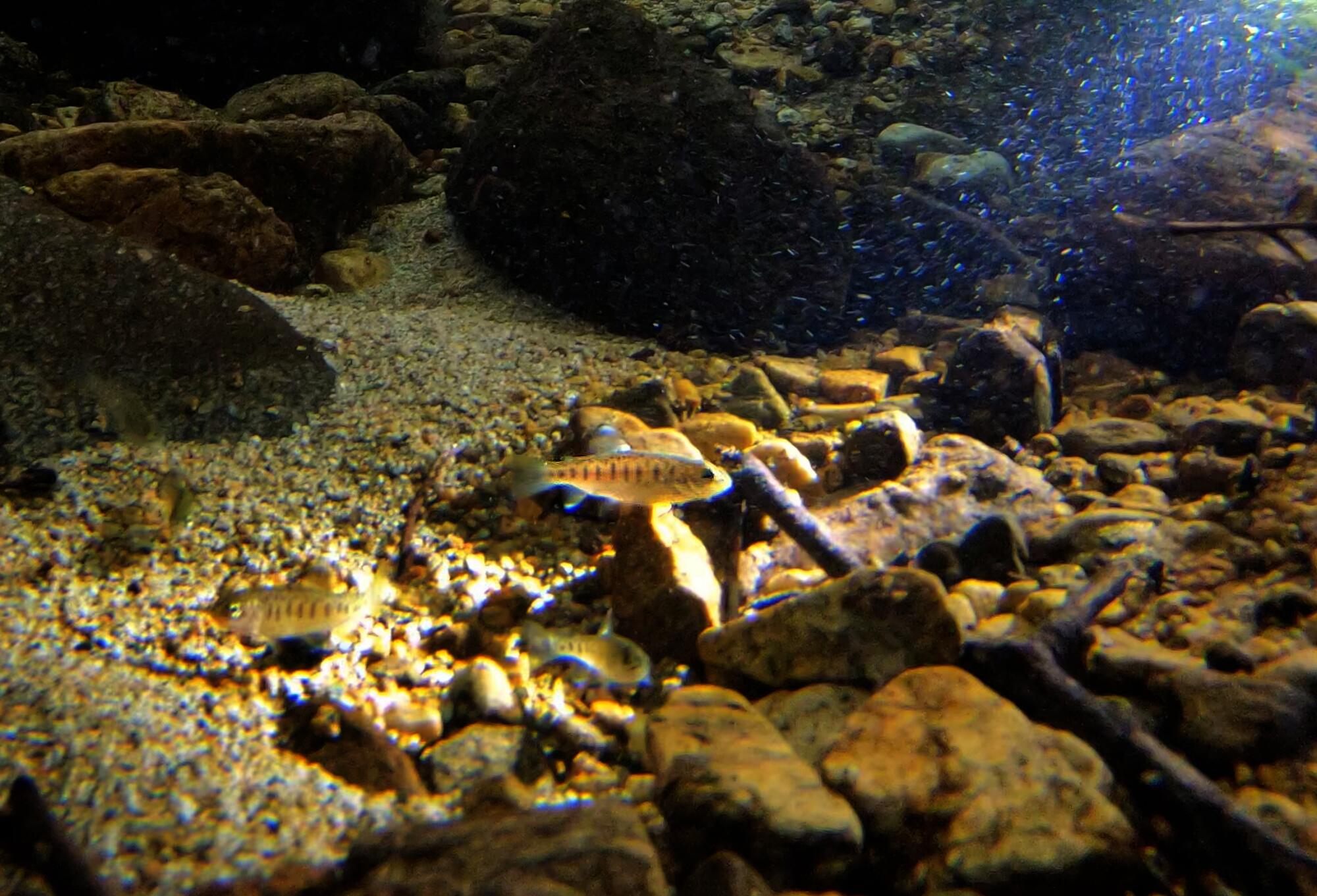
Last week however, the Arroyo Seco Foundation and the Pasadena Audubon Society announced that the city had agreed to discuss a settlement that may result in modifications of the project’s development plans.
“If settlement negotiations are successful, the finalized agreement will be presented at a Pasadena City Council hearing in July,” Brick said.
Biologists say that finding clear streams suitable for native rainbows — cool, rocky pools devoid of predatory invasive species — is becoming increasingly difficult in a mountain range with one of the most dangerous wildfire environments in the United States.
But the rainbows that were moved to the Arroyo Seco are swimming in good company. The creek is teeming with caddis flies, a primary food for wild fish, as well as trout ranging in size from 1-inch fry to 10 inches.
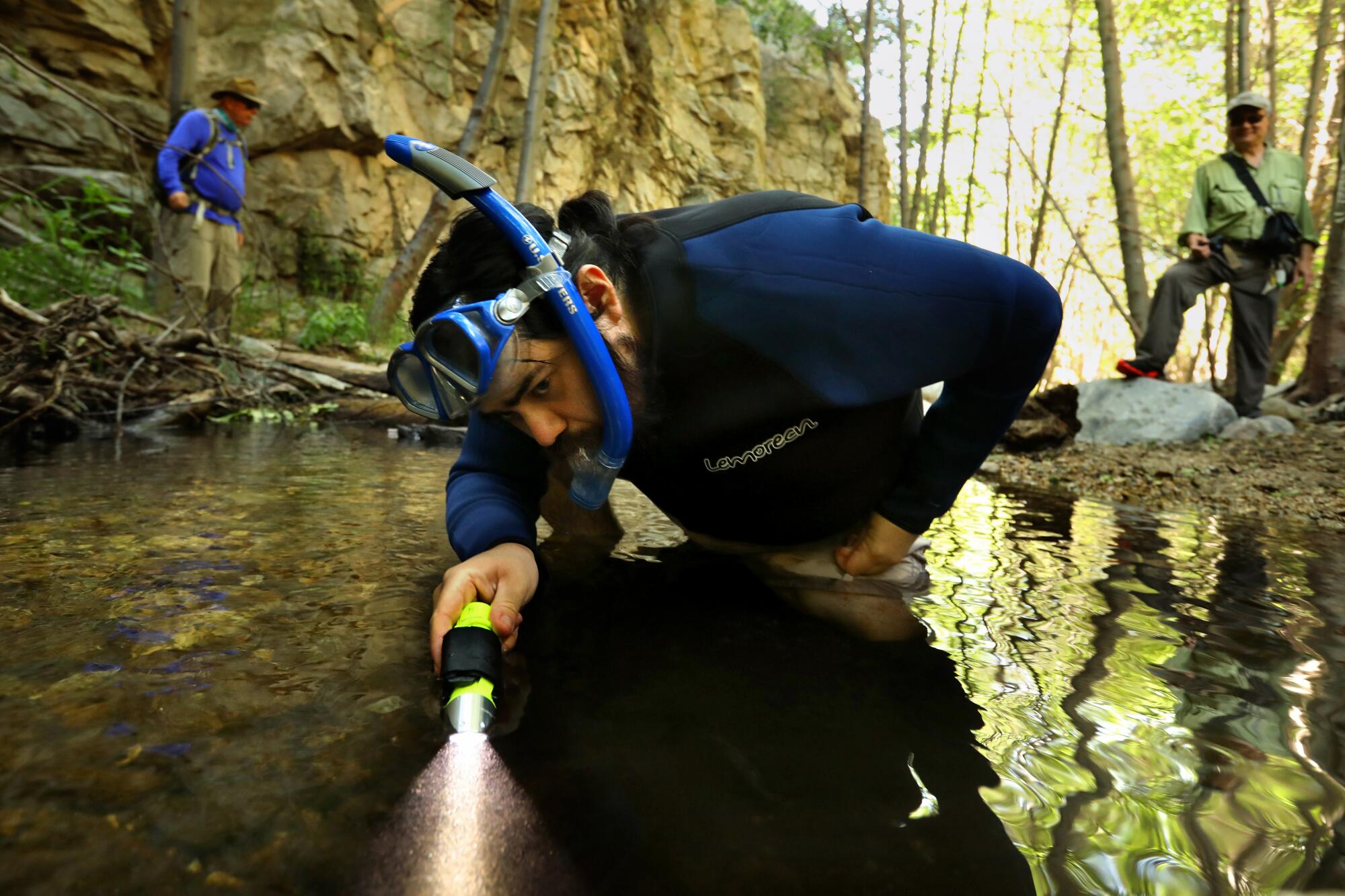
The Arroyo Seco was running clear and cool, shaded by alders, willows and bay trees, on a recent morning when Angel Pinedo put on a snorkel and mask and dunked his head into a pool to assess the status of the canyon’s trout population.
A beam from his hand-held flashlight moved in continuous arcs as Pinedo, an education director and designated “trout scout” for the Arroyo Seco Foundation, scanned the depths in search of the multihued fish with silvery white undersides, black spots along their backs, and a horizontal pink-red stripe running from the gills to the tail.
“Great news!” Pinedo, 35, said with a smile after lifting his head to the surface. “There are three baby rainbows right here, and they’re doing great — one to two inches in length, healthy and frisky.”
Over the next hour, Pinedo turned up several more rainbows in pools about 100 yards upstream.
Pinedo and other trout scouts began conducting informal weekly trout surveys in February to help orchestrate the species’ preservation along the Arroyo Seco.
“The big question now,” he said, “is whether these fish are the youngsters of the reintroduced rainbows or the descendants of historic populations that had been overlooked by the city’s surveys.”
“Either way,” he added, “we have fish in the Arroyo Seco and they need our help.”

For conservationists, the remote chance that some of the rainbow trout dumped into the stream could carry the genetic material to transform into a steelhead is thrilling.
Southern steelhead — a distant cousin of salmon — begin life as native rainbow trout. For still unknown reasons, some migrate to the ocean and become steelhead after undergoing physical changes that allow them to return to spawn in freshwater gravel beds.
Putting native rainbows in the creek, conservationists say, inadvertently complemented ongoing plans to modify the Los Angeles River so that steelhead can return to it. Modifications to the concrete channel south of downtown include terraces, riffles and pools that would allow southern steelhead to rest and bulk up during their migratory journeys north to ancestral spawning grounds that include such tributaries as the Arroyo Seco.
Steelhead have been prevented from making that journey since the 1930s, when frequent catastrophic flooding prompted civic leaders to transform the L.A. River into a flood-control channel. Nearly the entire 51-mile-long river bottom was concreted over except a few spots where the water table was too high.
Biologists and engineers are hoping to bring steelhead trout back to the concrete confines of the Los Angeles River.
The last steelhead recorded in the Los Angeles River was a 25-incher caught near a bridge in Glendale in 1940 — two years after that stretch was paved. Today, the region’s ocean steelhead population hovers around 500 — 10% of what it was seven decades ago.
Awareness of the river as a natural resource began to grow in the 1980s when environmental groups put pressure on Los Angeles County and the Army Corps of Engineers.
Now, the waterway is slowly being transformed into a greenbelt of parks, trees, bike paths and kayaking opportunities that set the stage for proposals that would allow the few southern steelhead left on Earth to fulfill their life stages in a renovated L.A. River watershed.
“In this case, we’re betting on the possible in the L..A. River,” said Tom Tomlinson, an expert on the cultural history of the Southern California steelhead.
“The return of a steelhead thoroughfare reconnecting the Arroyo Seco and the Pacific Ocean would reinforce the idea of L.A. culture as healthy, vigorous and outdoor friendly,” he said.
Those elements, he said, have caused the return of this fish to become “a precious quest.”

